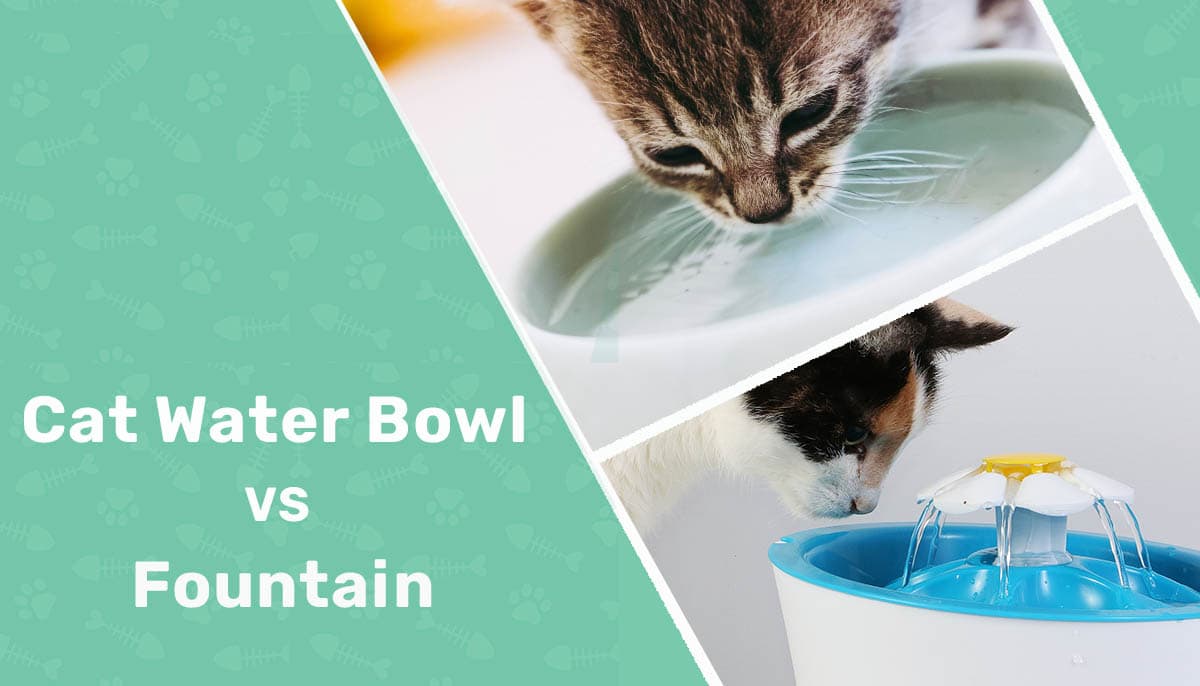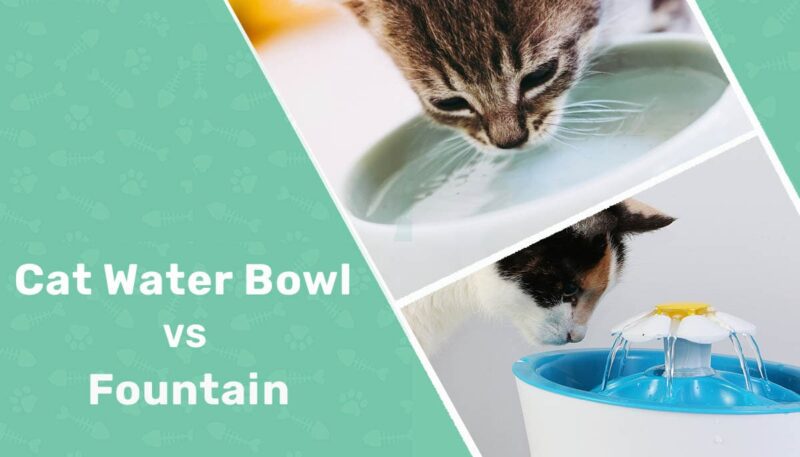Click to Skip Ahead
When you first adopt a cat, you’ll need a water bowl waiting at home to keep your pet hydrated. However, you can also purchase a water fountain to encourage your cat to drink more water. But surely it doesn’t matter if you provide a bowl or a fountain, right? It may actually matter to your feline since there are significant differences between a water bowl and a water fountain, and cats also have their preferences.
Visual Differences
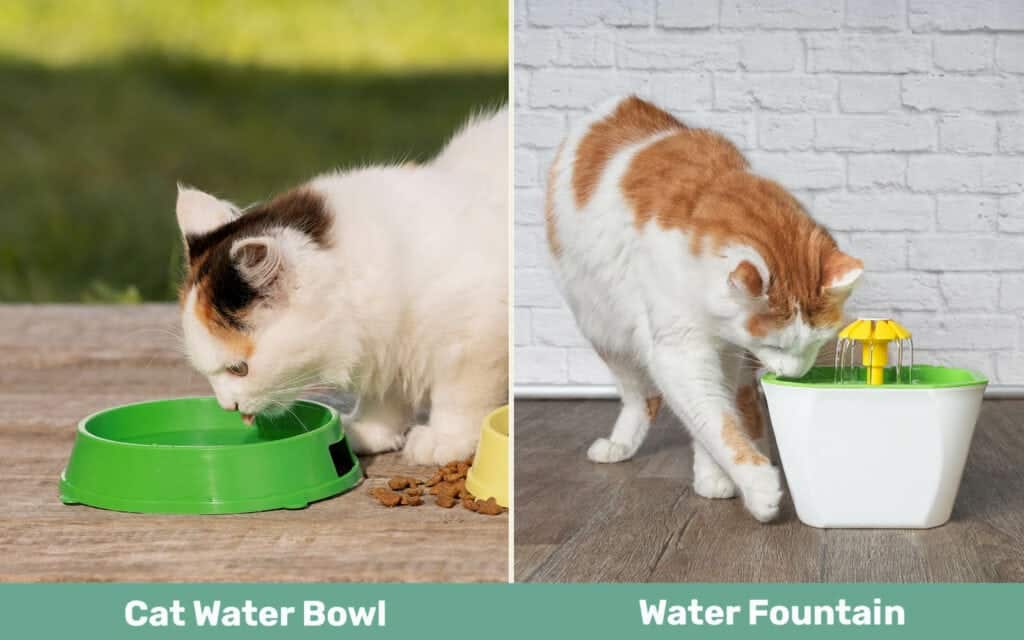
At A Glance
- Can use multiple water bowls for one cat
- Available in a variety of materials
- Water should be replaced every day
- Cheap and easy to replace
- Easy to clean
- Ideal for traveling
- Keeps the water flowing or running
- Filters the water
- Different types available
- Needs a power source
- Some cats prefer running water
- Perfect for picky cats

Overview of Water Bowl
A water bowl is precisely what its name implies. It is a bowl dedicated to holding water for your cat to stay hydrated. They are made of stainless steel, ceramic, glass, bamboo, and plastic, and you can easily place multiple water bowls in your home. Generally, water bowls are cheap, simple to clean, and easy to replace.
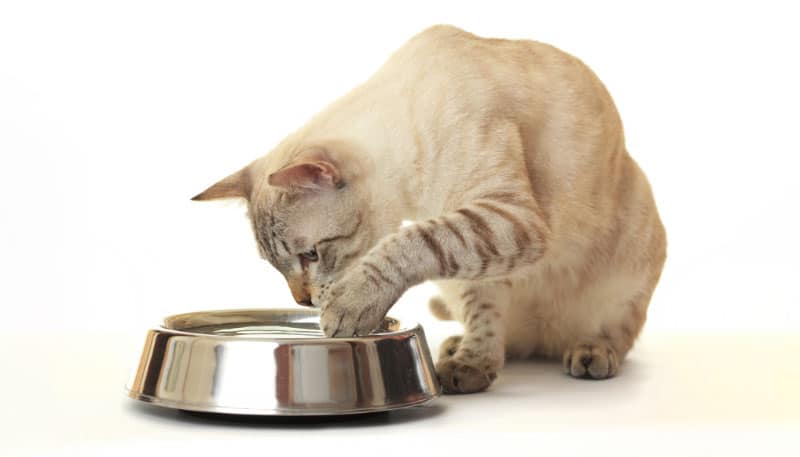
What Types of Water Bowls Are Available?
Water bowls are available in various materials, shapes, and sizes, and believe it or not, the bowl’s shape can be important to your cat. Tall, deep bowls can irritate your cat’s whiskers and prevent them from drinking if they’re too uncomfortable.
Although they’re inexpensive, plastic bowls can get cuts and dents that harbor bacteria, and some cannot be cleaned in the dishwasher.
Cats are known for their playful antics; one of the most common being pawing their water dish! The Hepper NomNom Cat Bowl was thoughtfully designed with these adorable yet messy cat behaviors in mind. Not only is the bowl spill-resistant, it features a wide wrap-around tray explicitly crafted to catch any splashes or spills. The two stainless steel dishes fit securely within the PP plastic base, keeping your kitty’s water in the bowl and off your floor! If you are always combating spills or dribbles caused by drinking, the Hepper NomNom Cat Bowl is the perfect option for you. At Catster, we’ve admired Hepper for many years and decided to take a controlling ownership interest so that we could benefit from the outstanding designs of this cool cat company!
What Type of Water Bowl Is Best?
The best material for cat water bowls is stainless steel. They are usually marked with numbers that represent the quality and corrosion resistance. The most popular steel grade for items used in food and water is grade 304 or 18/8. The advantage of stainless steel is that it is germ-resistant, lightweight, easy to clean, and dishwasher-safe. However, some cats may be spooked by their reflection in the bowl!
Glass and ceramic bowls are available, which are also easy to clean and dishwasher safe, but they can crack or chip easily, which can hurt your cat’s paws or mouth. You can also get cat bowls made from bamboo, which are great from an environmentally-friendly perspective.
They are strong and are made from 100% renewable bamboo. Try to find a bowl that is wide but not too deep and has a non-slip bottom so it doesn’t slide while your cat is drinking.
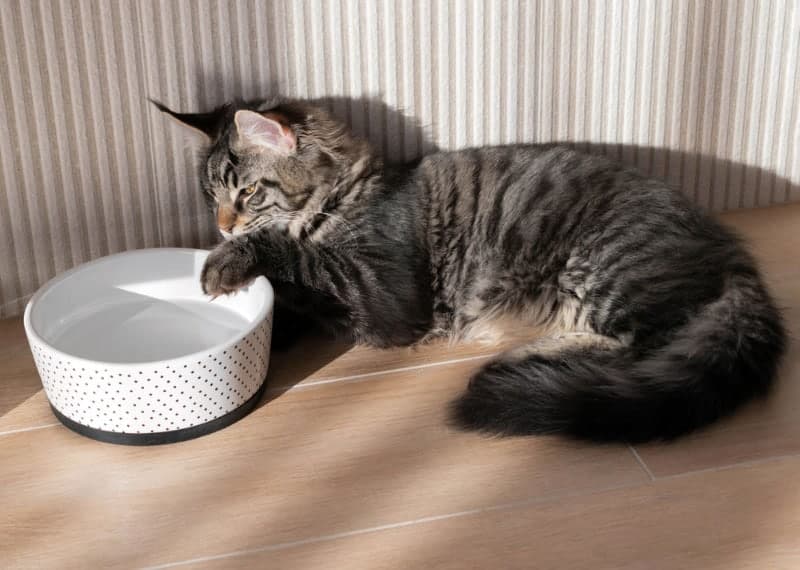
When to Choose a Water Bowl
Some cats have no issue with their bowl and will happily drink water from it. Bowls are also a better choice if you travel with your cat. You can have multiple bowls around the house in all the areas your cat likes to visit to ensure that they always have access to fresh water. A water bowl may also be best for a cat that doesn’t typically enjoy new gadgets or toys.
- Cheap and easy to replace
- Can have many around the house and move them around
- Easy to clean
- Low maintenance
- Easy to monitor and refill
- Many materials available
- Great for traveling
- Water can easily get stagnant, and bowls need to be thoroughly cleaned
- Some cats don’t enjoy standing water
- Some felines don’t enjoy the feeling of their whiskers touching the bowl
- Not enticing for a lot of cats
Overview of Water Fountain
A cat water fountain is a water bowl with constantly circulating water. It contains a filter to remove impurities and debris that build up in a standing bowl. They also come in various sizes, shapes, designs, and styles, which will determine the price. The fact that the water flows is the main difference from a water bowl, but another significant difference is that it requires a power outlet since it needs to be plugged in. A water fountain should appeal to feline instincts more than a water bowl.
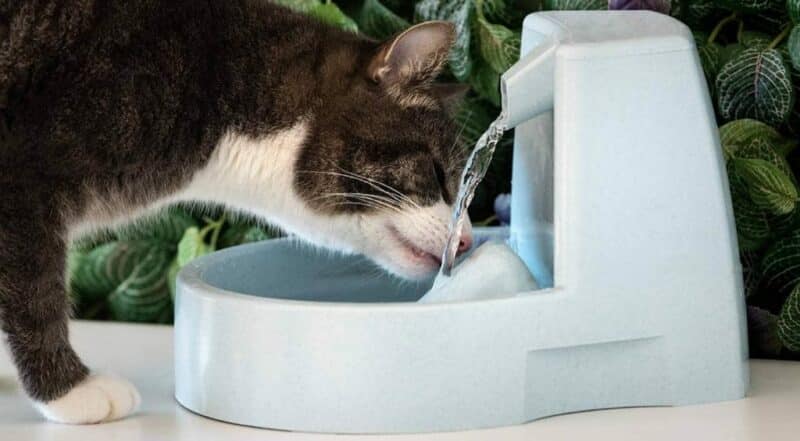
How It Works
The purpose of a water fountain is that the sound and the flowing water’s motion will draw the cats’ attention and entice them to drink. Some say this is because of their innate preference for flowing water, which would have been safer in the wild than stagnant pools. Your cat will want to drink more water because a water fountain’s continuous filtration and circulation keep the water tasting better and keeping it fresher for longer.
Some fountains have a high tap where the water comes out; in other models, the water enters the fountain through a bubbler before cascading into a pool at the base.
What Kinds of Water Fountains Are Available?
Cat water fountains are available in various designs to suit your cat’s preferences. Some fountains prioritize being quiet and discrete and have a soft pump and a slope that allows water to drop gently into the basin. There are also cat fountains that deliver a jet of water that drops into a basin, simulating the attractiveness of the bathroom tap. If you have several cats, you can buy a fountain with a large capacity to keep them hydrated.
Not every cat water fountain will make your life easier. This is why we recommend the well-designed Hepper Stainless Steel Cat Water Fountain, which has advanced triple filtration, three different flow modes, and an automatic shutoff feature.
This modern, minimalist fountain runs surprisingly quietly and is very easy to clean. At Catster, we’ve admired Hepper for many years and decided to take a controlling ownership interest so that we could benefit from the outstanding designs of this cool cat company!
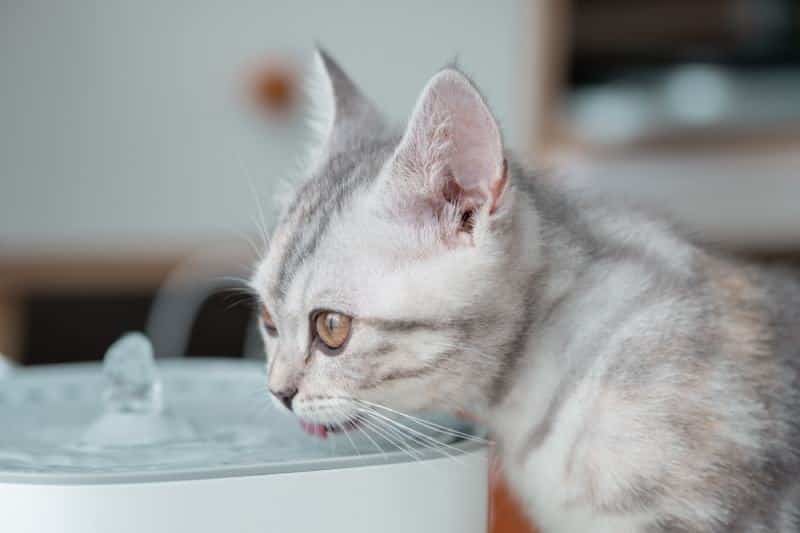
When to Choose a Water Fountain
A water fountain is a suitable choice if your cat is picky about water bowls or prefers drinking from running water. If you notice your cat drinking from the tap, they will most likely appreciate a water fountain over a bowl. If you are concerned about water going stagnant or you cannot change and wash the bowls regularly, a water fountain is the better option. It doesn’t need to be cleaned as often as water bowls, and the water is filtered to ensure it is clean.
- Water doesn’t get stagnant
- Ensures water is clean
- Ideal for a cat that is picky about their bowl or enjoys drinking from the tap
- It doesn’t need to be cleaned as often as water bowls
- Filters need to be replaced
- Needs to be plugged in
- Not suitable for traveling
- Expensive to have more than one in the house
It Is Essential to Ensure Your Cat Drinks Water
While cats aren’t big drinkers, it is still important for them to stay hydrated. Water in your cats’ diet is important for flushing out toxins from the kidneys, supporting digestion, maintaining body temperature, aiding circulation, and transporting and absorbing nutrients.
- If your cat doesn’t enjoy new gadgets and is happy with a water bowl
- If you need to provide multiple water sources around the house
- If you need to travel with your cat
- If you don’t have a power source for the fountain
- If you don’t want to replace filters frequently
- If your cat enjoys drinking from a tap
- If you are not around to change the water and wash bowls
- If your cat has a preference for running water
- If you are concerned about the quality of your tap water
- If you live in an area that is dusty or more likely to contaminate your cat’s water bowl
Conclusion
Every family with cats has bowls, which are inexpensive, easy to replace, and quick and easy to clean. However, not all cats enjoy water bowls and prefer drinking from running water. At the end of the day, it’s your cat that will make the choice. If your cat enjoys drinking from the tap or is not enticed by the water bowl, a water fountain may be the most suitable choice. If your cat has no problem with the bowl, you must ensure it is cleaned and the water is changed regularly. Stainless steel and ceramic are the best materials for water bowls since they do not harbor bacteria and can be cleaned in the dishwasher.
Featured Image Credit: (L) PicksArt, Shutterstock | (R) Bianca Grueneberg, Shutterstock

